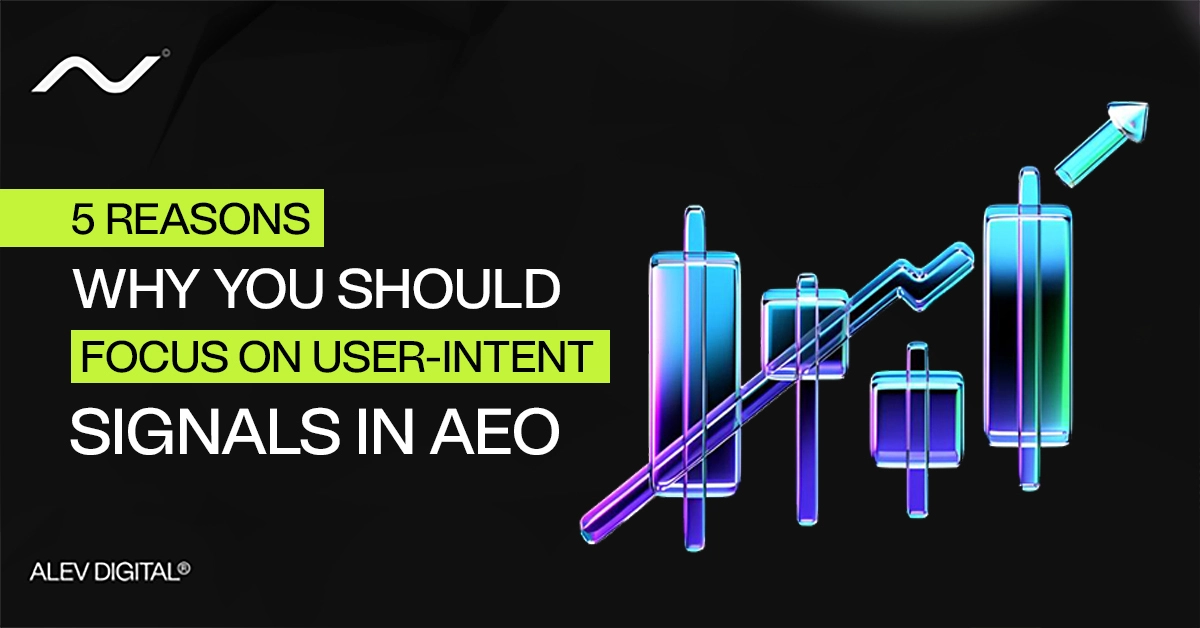Imagine searching for something online, clicking on a link, and finding… nothing useful. Frustrating, right? When the user intent is ignored in a website’s content strategy, that is exactly how users feel, and they just bounce. It is a pretty natural reaction because people just do not insert a random sentence into the search engines; they genuinely seek information, and if your content doesn’t deliver, they bounce. That’s how it works!
Since Answer Engine Optimization (AEO) has taken the web by storm, we have changed how we approach search visibility. Unlike traditional SEO, which focuses on keyword rankings, AEO is about delivering precise answers that directly meet user needs. The key to success is understanding and optimizing for user intent signals.
Ignoring user intent means missing out on valuable traffic and potential conversions. If your content isn’t providing immediate and relevant answers, users will move on, probably to a competitor. Learn why user intent signals should be at the heart of your AEO strategy.
What is AEO and How Does It Relate to User Intent?
Learn more about What is AEO in our previous blog. It is how content is structured to directly answer user queries in search results, featured snippets, and voice search responses, in simple words. The emphasis is on user queries throughout the process. It’s about making your content accessible and useful for users and search engines alike.
User intent is the foundation of answer engine optimization (AEO). If someone searches for “best marketing guide for beginners,” they expect clear recommendations, not a generic product page. Search engines prioritize content that aligns with intent, ensuring users get the best possible answers instantly.
Why Does User Intent Matter in AEO?
User intent is the heart and soul of effective AEO because it ensures that content speaks directly to users’ requirements. Users could look for quick facts, in-depth guides, or product comparisons. Since the emphasis is on users, they feel valued and treated as kings and queens for getting exactly what they asked for in their query. By understanding customer intent, you can create content that not only ranks but engages and satisfies users, which is a win-win situation for you and your users!
Ignoring user intent can be as bad as skipping your regular dose of medicine, and things do not just work for you. The disastrous results would be irrelevant content, low engagement, and poor search visibility. Search engines track how users interact with content; if visitors consistently leave quickly, it signals that the content isn’t useful, which can impact rankings and organic traffic.
What Does a Lack of User Intent Optimization Cause?
After figuring out its importance, you should think twice before skipping user intent in your content strategy. If the user intent is ignored, there is an endless list of consequences that act like havoc for the entire marketing funnel. These are not all, but some of the consequences that the inclusion of user intent mitigates:
- High bounce rates: Users look for inclusivity, and when they land on a page that doesn’t match their intent, they leave immediately without a second thought. This signals search engines that your content isn’t valuable, lowering rankings.
- Low engagement and conversions: Why would a user engage if he does not feel included with relevant intent signals? They simply won’t stay long enough to take action, such as signing up, purchasing, or exploring further.
- Reduced visibility in search results: Even the search engines focus on user intent by prioritizing content that satisfies users. If your content does not focus on that, it’s less likely to appear in featured snippets and other high-visibility placements allocated by search engines.
- Unsatisfactory user experience: When users get frustrated, they will never prefer your website, and the worst disadvantage is that it damages brand trust and retention.
5 Reasons to Include User Intent Signals in AEO
So, if skipping the user intent could cause much trouble to all marketers, then its inclusion must have jaw-dropping benefits. Here are a few reasons why relying on customer behaviors or user intents is so important:
1. Higher Search Rankings
Search engines prioritize content that effectively answers user queries. When your content aligns with user intent, it’s more likely to appear in featured snippets, “People Also Ask” boxes, and voice search results. Optimizing for intent ensures your content gets noticed and ranks higher, driving more organic traffic to your site.
2. Increased Conversion Rate
Finding precisely what you have been looking for sounds like a victory, and users feel the same way. So, the chances just multiply of having users end up taking an action like signing up, making a purchase, booking a consultation, or whatever the goal is. Intent-driven content builds trust and confidence, making it easier for users to commit. Understanding user intent enables you to craft compelling CTAs that drive higher conversion rates.
3. Better User Experience
What does an ideal user experience look like? When the content and distribution of content is appealing to the user, it meets the set expectations. When users don’t have to dig through fluff to get answers, they stay longer and engage more. Optimizing for intent ensures a smooth, frustration-free journey, keeping visitors satisfied and more likely to return to your site.
4. Increased Engagement & Retention
When content aligns with user intent, visitors stay longer, explore, and return for more. This not only boosts engagement metrics but also strengthens brand authority. When the content relates to the users, the chances of retaining loyal visitors who trust your site for accurate answers increase.
5. Improved Voice Search & AI Optimization
With voice search and AI-powered search engines proliferating, optimizing for intent is more important than ever. Since voice searches often involve question-based queries, structuring content around clear, direct answers enhances visibility in voice search results, ensuring your content is featured in AI-driven responses.
Get A Step Closer to Answer Engine Optimization with Alev Digital
So, if you haven’t really cracked this strategy yet, then there is no need to. That’s what we are for! Alev Digital does not only create content that resonates with target audiences but also content that is AEO-optimized. When we say it is optimized for answer engines, we mean it perfectly aligns with user intent signals and is optimized for featured snippets and voice search assistants. With us, reaching the right audience at the right time is the easiest.
Want to boost your search visibility and engagement? Let’s make it happen.
Frequently Asked Questions
AEO is the process of optimizing website content to provide direct, relevant answers in search results, featured snippets, and voice searches.
Search engines prioritize content that directly satisfies user intent, leading to higher rankings and better visibility.
Content that aligns with user intent keeps visitors engaged, reduces bounce rates, and improves conversions.
Use conversational language, structure content around common questions, and provide clear, concise answers.
AEO helps increase search visibility, improve user experience, and route organic traffic to your site.





